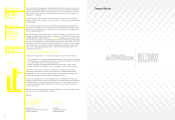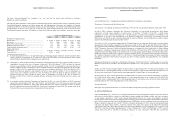Blizzard 2014 Annual Report Download - page 20
Download and view the complete annual report
Please find page 20 of the 2014 Blizzard annual report below. You can navigate through the pages in the report by either clicking on the pages listed below, or by using the keyword search tool below to find specific information within the annual report.
19
As previously disclosed, on July 9, 2008, the Business Combination occurred among Vivendi, the Company and certain of
their respective subsidiaries pursuant to which Vivendi Games, then a member of the consolidated U.S. tax group of
Vivendi’s subsidiary, Vivendi Holdings I Corp. (“VHI”), became a subsidiary of the Company. As a result of the Business
Combination, the favorable tax attributes of Vivendi Games carried forward to the Company. In late August 2012, VHI
settled a federal income tax audit with the Internal Revenue Service (“IRS”) for the tax years ended December 31, 2002,
2003, and 2004. In connection with the settlement agreement, VHI’s consolidated federal net operating loss carryovers were
adjusted and allocated to various companies that were part of its consolidated group during the relevant periods. This
allocation resulted in a $132 million federal net operating loss allocation to Vivendi Games. In September 2012, the
Company filed an amended tax return for its December 31, 2008 tax year to utilize these additional federal net operating
losses allocated as a result of the aforementioned settlement, resulting in the recording of a one-time tax benefit of
$46 million. Prior to the settlement, and given the uncertainty of the VHI audit, the Company had insufficient information
to allow it to record or disclose any information related to the audit until the quarter ended September 30, 2012, as disclosed
in the Company’s Quarterly Report on Form 10-Q for that period.
Vivendi Games results for the period January 1, 2008 through July 9, 2008 are included in the consolidated federal and
certain foreign state and local income tax returns filed by Vivendi or its affiliates while Vivendi Games results for the
period July 10, 2008 through December 31, 2008 are included in the consolidated federal and certain foreign, state and local
income tax returns filed by Activision Blizzard. Vivendi Games tax years 2005 through 2010 remain open to examination
by the major taxing authorities. The IRS is currently examining Vivendi Games tax returns for the 2005 through 2008 tax
years.
Activision Blizzard’s tax years 2008 through 2013 remain open to examination by the major taxing jurisdictions to which
we are subject. The IRS is currently examining the Company’s federal tax returns for the 2008 through 2011 tax years.
Additionally, the IRS is currently reviewing the Company’s application for an advanced pricing agreement (“APA”) with
respect to the transfer pricing methodology that would be used by the Company for tax years 2010 through 2024. If ongoing
discussions with the IRS result in an APA, this could result in a different allocation of profits and losses under the
Company’s transfer pricing agreements. Such allocation could have a positive or negative impact on the Company’s
provision for uncertain tax positions for the period in which such an agreement is reached and the relevant periods
thereafter. The Company also has several state and non-U.S. audits pending.
Although the final resolution of the Company’s global tax disputes is uncertain, based on current information, in the
opinion of our management, the ultimate resolution of these matters will not have a material adverse effect on the
Company’s consolidated financial position, liquidity or results of operations. However, an unfavorable resolution of the
Company’s global tax disputes could have a material adverse effect on our business and results of operations in the period
in which the matters are ultimately resolved.
The overall effective income tax rate in future periods will depend on a variety of factors, such as changes in the mix of
income by tax jurisdiction, applicable accounting rules, applicable tax laws and regulations, and rulings and interpretations
thereof, developments in tax audits and other matters, and variations in the estimated and actual level of annual pre-tax
income or loss. Further, the effective tax rate could fluctuate significantly on a quarterly basis and could be adversely
affected by the extent that income (loss) before income tax expenses (benefit) is lower than anticipated in foreign regions
where taxes are levied at relatively lower statutory rates and/or higher than anticipated in the United States where taxes are
levied at relatively higher statutory rates.
A more detailed analysis of the differences between the U.S. federal statutory rate and the consolidated effective tax rate, as
well as other information about our income taxes, is provided in Note 17 of the Notes to Consolidated Financial Statements
included in this Annual Report.
Foreign Exchange Impact
Changes in foreign exchange rates had a negative impact of $8 million, a positive impact of $20 million, and a negative
impact of $67 million on Activision Blizzard’s consolidated operating income in 2014, 2013 and 2012, respectively. The
change is primarily due to changes in the value of the U.S. dollar relative to the euro and British pound and its impact on
our foreign operating income.
For the year ended December 31, 2014, given that the majority of the Company’s GAAP net consolidated operating income
is generated in the first half of the fiscal year due to the impact of deferrals, where the euro and British pound strengthened
against the U.S dollar as compared to the same period in 2013, the negative impact from the significant weakening of the
euro and British pound relative to U.S. dollar in the later stages of 2014 was largely offset in on the Company’s
consolidated operating income for the full year 2014.
20
Liquidity and Capital Resources
Sources of Liquidity (amounts in millions)
For the Years Ended December 31,
2014 2013
Increase
(Decrease)
2014 v 2013
Cash and cash equivalents ........................................................................ $ 4,848 $ 4,410 $ 438
Short-term investments ............................................................................ 10 33 (23)
$ 4,858 $ 4,443 $ 415
Percentage of total assets ......................................................................... 33% 32%
For the Years Ended December 31,
2014 2013 2012
Increase/
(Decrease)
2014 v 2013
Increase/
(Decrease)
2013 v 2012
Cash flows provided by operating activities ................. $ 1,292 $ 1,264 $ 1,345 $ 28 $ (81)
Cash flows (used in) provided by investing activities ... (84) 308 (124) (392) 432
Cash flows used in financing activities ......................... (374) (1,223) (497) 849 (726)
Effect of foreign exchange rate changes ....................... (396) 102 70 (498) 32
Net increase in cash and cash equivalents ..................... $ 438 $ 451 $ 794 $ (13) $ (343)
Cash Flows Provided by Operating Activities
The primary drivers of cash flows provided by operating activities typically include the collection of customer receivables
generated by the sale of our products and digital and subscription revenues, partially offset by payments to vendors for the
manufacturing, distribution and marketing of our products, payments for customer service support for our subscribers,
payments to third- party developers and intellectual property holders, payments for interest on our debt, payments for
software development, payments for tax liabilities, and payments to our workforce.
Cash flows provided by operating activities were slightly higher for 2014, as compared to 2013, primarily due to a more
favorable impact from changes in our working capital accounts, mainly related to cash flows from revenues which were
deferred. Cash flows provided by operating activities for the year ended December 31, 2014 included approximately
$201 million of interest paid for the Notes and Term Loan, as compared to $57 million for the same period in 2013. Cash
flows provided by operating activities were lower for 2013, as compared to 2012, primarily due to lower net income and its
impact on changes in our working capital accounts.
Cash Flows (Used in) Provided by Investing Activities
The primary drivers of cash flows provided by (used in) investing activities typically include the net effect of purchases and
sales/maturities of short- term investments, capital expenditures, and changes in restricted cash balances.
Cash flows used in investing activities were $84 million in 2014, as compared to cash flows provided by investing activities
of $308 million in 2013. Lower cash flows from investing activities were primarily due to lower proceeds from the maturity
of investments and a higher investment in capital expenditures. In 2014, proceeds from maturities were $21 million, the
majority of which consisted of U.S. treasury and other government agency securities. Further, capital expenditures during
2014, primarily related to property and equipment, were $107 million.
Cash flows provided by investing activities were higher for 2013, as compared to 2012, primarily due to lower purchases of
short-term investments. In 2013, proceeds from the maturity of investments were $304 million, the majority of which
consisted of U.S. treasury and other government agency securities, and proceeds from sales of available-for-sale
investments were $98 million, while purchases of short-term investments totaled $26 million. Further, capital expenditures,
primarily related to property and equipment, were $74 million.
























